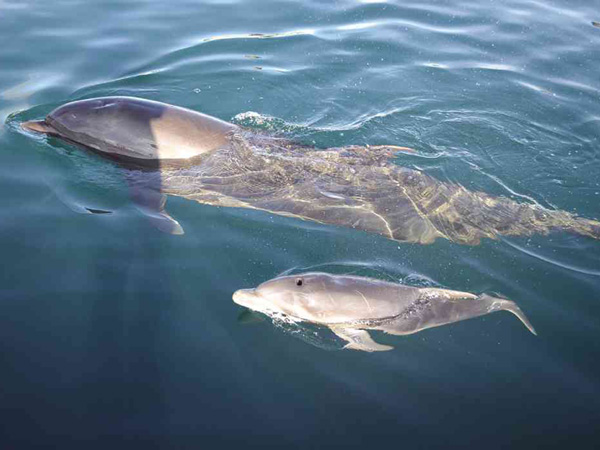Dolphin born in captivity dies of infection

MOTHER dolphin “Vi” and her calf while nursing. After two weeks, the first dolphin calf born in captivity in the country died of an infection. Ocean Adventure officials said the mother dolphin could get pregnant and give birth again in three years,
“with better chances.” PHOTO FROM OCEAN ADVENTURE
SUBIC BAY FREEPORT—The first dolphin born in captivity in the country died on Sunday due to an infection and a weak immune system, an official of the marine theme park Ocean Adventure here said.
Timothy Desmond, chair and chief executive officer of Subic Bay Marine Exploratorium Inc. (SBMEI), the firm that runs Ocean Adventure, said the bottlenose dolphin calf died on Sunday after an infection in the lungs and liver.
“It takes awhile for the antibodies from its mother to [develop]. There is a high mortality rate in the first month, in captivity or in the wild,” he said.
The dolphin calf, born at 7 p.m. on July 6 at a special birthing pen and nursing lagoon in Ocean Adventure, measured less than a meter and weighed about 12 kilograms.
“Vi,” the calf’s mother, was under the care of Ocean Adventure trainers who recorded swimming patterns and respiration rates and nursing bouts by the calf.
Her trainers said Vi trained with a special dolphin “puppet” to encourage nursing behavior and, throughout the yearlong pregnancy, she continued to participate in Ocean Adventure’s training sessions and programs.
In a statement, Carlo Magno, the marine park’s director for animal care department, said Vi had done everything right as a mother.
“She pushed the baby to the surface for his first breath, helped him avoid the walls and increased his lung capacity by taking him for progressively longer and deeper swims underwater. Within five hours the baby was nursing, an impressive short time frame for most newborn dolphins,” Magno said.
He said baby dolphins were very vulnerable as every scratch on their delicate skin “is a potentially lethal source of infection until their immune system develops several days after birth.”
“They must swim continually to stay afloat with a soft tail that takes hours to become rigid enough for efficient swimming. He will be at risk for the first 30 days,” he said.
Desmond said a necropsy performed on the calf confirmed that it died of infection.
“It takes time for their immunity to stabilize. There is a
50-percent chance of [calf survival] for first-time moms like Vi. At the start, everything was perfect. She was able to nurse properly, but the infection hit,” he said.
Despite the calf’s death, Desmond said Vi could now be considered “an experienced mom.”
“Dolphins give birth to a calf about every three years. It’s likely that she can get pregnant and give birth again, with better chances this time,” he said. Robert Gonzaga, Inquirer Central Luzon